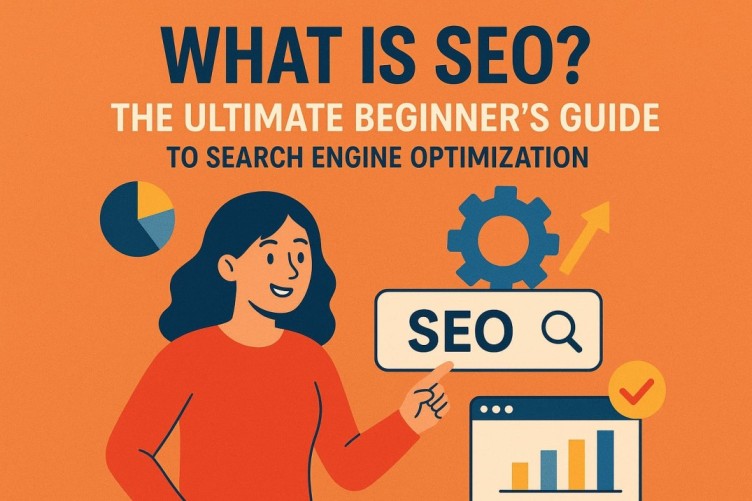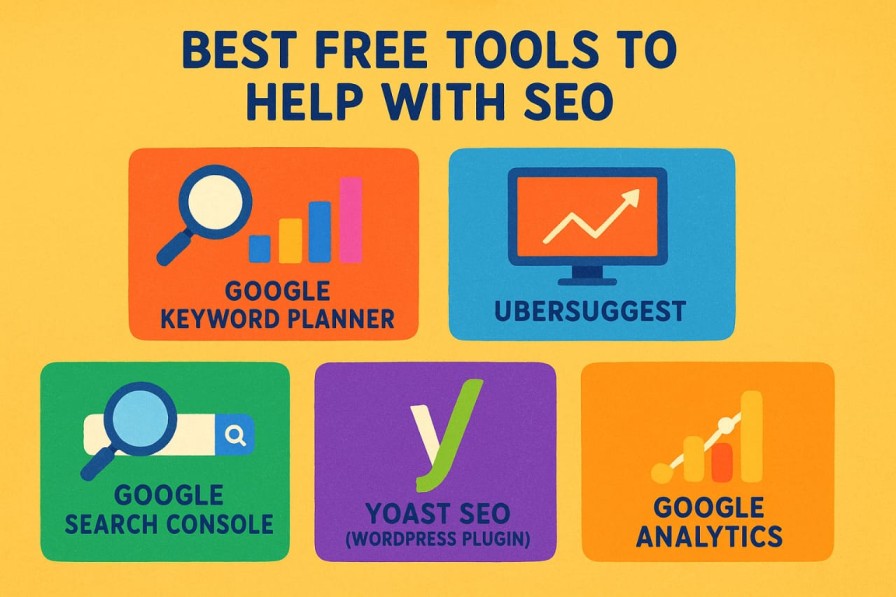New to SEO? Discover what Search Engine Optimization really means, why it matters, and how beginners can use simple strategies to rank higher on Google. This ultimate guide makes SEO easy to understand and apply.

Introduction : Why Everyone Talks About SEO?
Imagine you open a new ice cream shop in your neighborhood. You have 20 yummy flavors, but only a few people know your shop exists. How do you make sure more people come, without shouting on the street all day ? That’s where SEO comes in !
SEO = Search Engine Optimization.
In simple words:
SEO is like putting a big, shiny sign on your shop so that people can find you easily on Google.
Whenever someone types: “Best ice cream near me” “Strawberry ice cream shop”
…your shop shows up at the top of the search results. That’s the magic of SEO.
By the end of this guide, you’ll understand what SEO is, how it works, and how even a beginner (like you or me) can start using it.
Chapter 1: What Exactly is SEO?
SEO means making small changes to your website so that search engines like Google can understand it better and show it to the right people. Think of Google as a librarian. Millions of websites are like books. The librarian (Google) has to decide which book (website) to show first when someone asks a question.
SEO is just about making your “book” easy for the librarian to find and recommend.
In short:
• SEO helps websites rank higher on search engines. • Higher ranking = more visitors = more sales/money/opportunities.
Chapter 2: How Does SEO Work? (Simple Explanation)
Let’s break it down step by step.
1. Crawling – Google’s robots (called crawlers) go around the internet, reading websites like little detectives.
2. Indexing – Google saves the information in its huge “library.”
3. Ranking – When you search for something, Google shows the “best and most trusted” websites first.
So if your site has good SEO, Google will say:
“This looks useful, let’s put it on page.”
Chapter 3: The 3 Main Parts of SEO
SEO isn’t just one thing—it has 3 main parts:
1. On-Page SEO (What’s on your website)
•Writing good content with keywords.
•Using headings and subheadings.
•Adding images, videos, and links.
Example: If your page is about ice cream, don’t just say “ice cream.” Say “best ice cream flavors in New York.”
2. Off-Page SEO (What others say about you)
•Getting links from other websites (backlinks).
•Having people talk about your brand online.
•Social media shares.
Example: If food bloggers write about your ice cream shop and link to your site, Google thinks: “This must be popular!”
3. Technical SEO (Behind-the-scenes stuff)
•Fast website speed.
•Mobile-friendly design.
•Safe browsing (HTTPS).
Example: If your site takes 10 seconds to load, people leave. Google notices and pushes your site lower.
Chapter 4: Why SEO is Important (Even for Beginners)
SEO is not just for big companies. Even small businesses, students, and bloggers need it.
Here’s why:
•Free traffic: You don’t pay Google for clicks (unlike ads).
•Trust & credibility: People trust websites on page 1 more.
•Better visibility: More people find you, more chances to grow.
•Long-term results: Once you rank, you keep getting traffic.
Fun fact: 75% of people never go past page 1 on Google. If you’re not there, you’re invisible!
Chapter 5: How to Start SEO as a Beginner (Step-by-Step)
Now that you know what SEO is, let’s see how you can actually do it.
Here’s a super simple step-by-step guide for beginners
1. Find the Right Keywords
•Keywords are the words people type into Google.
•Example: Instead of just “ice cream,” people type “best chocolate ice cream near me.”
•Use free tools like Google Keyword Planner or Ubersuggest to find what people are searching.
2. Write Helpful Content
Google loves useful content. If someone clicks on your site and finds the answer they need, Google will reward you with better ranking.
Tips:
•Use headings (H1, H2, H3) to organize content.
•Add images, videos, and bullet points to make it easy to read.
•Keep sentences short and clear (like this guide).
3. Optimize Your Page
This means making small tweaks to help Google understand your page.
•Put your keyword in the title.
•Add it in the first paragraph.
•Use it in headings and meta descriptions.
5. Get Backlinks (Links from Other Websites)
•Test your site speed on Google PageSpeed Insights.
•Use a simple, mobile-friendly design.
5. Get Backlinks (Links from Other Websites)
This is like votes of confidence. The more quality sites link to you, the more Google trusts you.
You can:
•Write guest posts.
•Share your content on social media.
•Collaborate with bloggers.
Chapter 6: Common SEO Mistakes Beginners Make
Many beginners mess up because they try to “trick” Google. Let’s save you from that!
Mistake 1: Keyword Stuffing
Example: “Our ice cream shop has the best ice cream because ice cream is tasty and ice cream is cheap…”
Google hates this. It looks fake.
Mistake 2: Ignoring Mobile Users
Most people search on their phones. If your site doesn’t open well on mobile, you lose visitors.
Mistake 3: Copying Content
Copying from other sites = bad. Google only wants original content.
Mistake 4: Not Tracking Results
If you don’t check what’s working, you’ll never improve.
Chapter 7: Best Free Tools to Help with SEO
Good news: You don’t need to spend a fortune. There are free tools that make SEO super easy.
Here are some beginner-friendly ones:

1. Google Keyword Planner – Find what people are searching.
2. Ubersuggest – See keyword ideas and traffic.
3. Google Search Console – Track how your site is performing.
4. Yoast SEO (WordPress Plugin) – Helps optimize content.
5. Google Analytics – Shows where your visitors come from.
Pro tip: Start with just Google Search Console + Google Analytics. Both are free and powerful.
Chapter 8: Real-Life Example of SEO Success
Let’s look at a simple story.
Sarah runs a small bakery. At first, she only sold to locals. Then she started a blog with recipes like:
“Best Chocolate Cake Recipe”
“How to Bake Cookies at Home”
She used SEO basics:
•Picked the right keywords.
•Wrote clear, helpful posts.
•Shared them on social media.
Within 6 months, her website traffic grew by 5x. People from other cities started ordering her cakes online.
This shows how SEO can change a small business into a big success.
Chapter 9: The Future of SEO (What’s Coming Next)
SEO is always changing. In the future, these trends will grow:
1. Voice Search – People use Siri, Alexa, and Google Assistant more. (Example: “Hey Google, best pizza near me.”)
2. AI & Chatbots – Search engines use Artificial Intelligence to give smarter results.
3. Video SEO – YouTube videos are also part of SEO.
4. Local SEO – More “near me” searches are happening every day.
If you’re starting now, you’re in the right place. SEO will only get bigger!
Chapter 10: Final Tips to Win at SEO.
Before we wrap up, here are some golden rules for beginners:
•Focus on people, not Google. Write content that helps humans first.
•Be consistent. SEO takes time—don’t expect overnight results.
•Keep learning. SEO changes often. Stay updated with blogs and YouTube channels.
•Don’t give up. Even small improvements can bring big traffic over time.
Conclusion
So, let’s quickly recap what you’ve learned in this guide:
•SEO = Search Engine Optimization = making your website show up higher on Google •It works like a library system (crawling, indexing, ranking) •SEO has 3 parts: On-Page, Off-Page, Technical. •Beginners can start with simple steps: keywords, content, page speed, backlinks. •Avoid mistakes like keyword stuffing and copying. •Use free tools to make life easier. •SEO brings free, long-term traffic and builds trust.
Remember: SEO is not magic—it’s about being helpful, consistent, and smart. If you start today, your website could be the one people find tomorrow!
Pingback: Future of SEO in 2025: AI, Voice Search & Game-Changing Trends You Can’t Ignore - auraclix
Pingback: Biggest SEO Mistakes Beginners Make (And How to Fix Them in 2025) - auraclix
Pingback: On-Page SEO Checklist 2025: Step-by-Step Guide to Rank Your Blog - auraclix